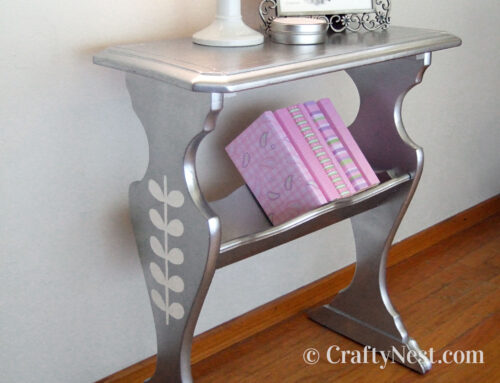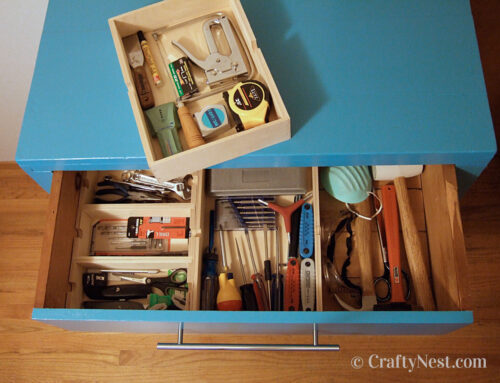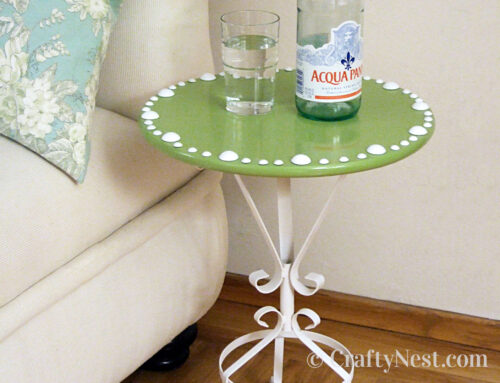Plain bookshelf = DIY fancy china cabinet

This small unfinished pine bookshelf was shuffled from room to room. I planned to paint it, but never did. I was on the verge of kicking it to the curb. (This post contains affiliate links. If you use these links to buy something, I may earn a small commission. You can read my full disclosure here.)
Then, after unsuccessfully searching for a china cabinet for my tiny dining room, I decided to dress up this bookshelf and use it as a china cabinet. I loaded it with dishes, vases, candlesticks, and napkins. My palette was inspired by Iris’ dishes in the movie The Holiday. (Iris was played by Kate Winslet.) Don’t I wish I had her cottage kitchen too.

I started with a sketch (see below). I wanted to lift the shelves off the ground, hence the legs. I also added crown molding and trim boards on each shelf. After a friend cut and routered all the wood I had piled in my car, I was ready to start building.
I bought the molding and other pieces of wood (for trim and reinforcement) at a nearby salvage yard. I love salvage yards (two others that I frequent are Urban Ore and Omega Salvage). But beware: Most salvage yards are for-profit businesses, and they often aren’t cheaper than buying brand new, so compare prices first.
My first DIY projects appeared in Sunset magazine’s now defunct blog, Home By Sunset. This post is an updated version of “Dressing up a boring bookshelf, part 1-3,” originally published August 7-27, 2007.
How to dress up a boring bookshelf
SUPPLIES
TOOLS
INSTRUCTIONS

1. Start with a sketch to record the bookshelf’s measurements and determine the amount and lengths of wood trim you’ll need.
2. Remove the back of the bookshelf. Mine was falling off anyway, so I removed the rest of the staples it was hanging on with. Use a flathead screwdriver, hammer, and needle-nosed pliers to remove the staples.

3. Gather all the wood pieces needed including moldings, legs, and skirt pieces. As you will see below, the plan changed slightly from my original sketch. I decided that attaching the bookshelf on top of a table base would work better. First, cut a 1×10 the same size as the top shelf of the bookshelf to use as a tabletop. Then choose a piece of wood to use as a skirt. A 1×4 works well. I used a curvy piece of wood that I found at a salvage yard to use as my skirt.

4. Place the edges of each leg flush with the corner of your tabletop. Mark and pre-drill holes, and attach each leg to the tabletop with a 5/16-inch lag bolt. Then measure and cut the skirt pieces to fit snug between the table legs (front and two sides). Inset the skirt a quarter inch from the edge of the tabletop, and attach the pieces with L-brackets, screws, and wood glue.

5. Clamp the skirt pieces to the tabletop and hammer in a few nails from the top to secure the skirt. I used finish nails and a nail set.

6. Place the bookshelf on top of your table as in the picture at step #3. Because the skirt is inset ¼ inch, you will be able to hammer a few nails through the tabletop (bottom to top) into the bottom of bookshelf on both sides. That, along with wood glue, will attach the bookshelf to the base. It’s not as secure as we need it yet, which is partly why we’ll add the trim boards below.

7. You will need a wider surface to attach the crown molding to. Glue, clamp, and nail pieces of wood around the top edge of the bookshelf to support the crown molding. I used 1x2s at the front, sides, and part of the back.

8. Cut a 1×10 the same size as your bookshelf, then glue, clamp, and nail it down to your reinforcement pieces. This is the new top of your bookshelf.

9. Attach the crown molding at the top (front and sides), the trim pieces at the bottom (front and sides), and the three shelf trim boards (front). Use wood glue, finish nails, and a nail set (to counter-sink the nails). The job is much easier with a electric nail gun, but it can be done without one. Make sure you hammer nails into the top and bottom edge of the trim boards that cover the base of your bookshelf, to secure the bookshelf to the table base.
Tip: It’s hard to hold the boards in place by yourself and hammer the nails, so find a helper for this step. I had to yank out a nail or two and start over.
10. Use wood filler to fill all the nail holes, and use caulk to fill in gaps at the corners and edges of the molding. I find wood filler much easier to work with because I can always sand out mistakes when it dries. Caulk? Not so much.

11. Sand all the surfaces and remove the dust with a vacuum and tack cloth. Then paint one coat of primer and two coats of paint. For larger areas, use a small paint roller, which makes the job faster and eliminates brush strokes.
Tip: Don’t be tempted to buy cheap paint rollers and brushes. You’ll end up tossing them and buying better ones. Splurge on the good stuff for a smoother, more even finish. And the job will go much faster. Click here for more painting tips from a pro.
12. Either reattach your original backing or replace it with a sheet of bead board, like I did. I painted mine pale blue (Behr Prelude 740E-3). When the paint is dry, nail it to the back of the shelf unit.

13. Measure and mark where you want your cup hooks placed. I attached eight evenly spaced along the top shelf. However, I encountered a problem: My drill wouldn’t fit between the shelves. So I hammered a nail into each spot, yanked it out, and screwed a cup hook into each nail hole. If you have a smaller drill (or larger bookshelf), you will not have this problem.

14. My bookshelf is tall, skinny, and a bit top heavy, so it needed to be bolted to the wall, as most bookshelves do. Screw two L-brackets into the wall, one at each side, then screw the top of each bracket to the top of the shelf unit.
Tip: When anchoring to drywall, use a stud sensor to find a stud, then drill there. Or use a drywall anchor or molly bolt.

Share this story
Reader Gallery
Made this project? Email your photo(s) to monica (at) craftynest (dot) com, and I’ll share your version here!







THANK YOU for putting the finished project 1st! I get annoyed with posters that make you scroll for 5 minutes to see the finished piece!!!